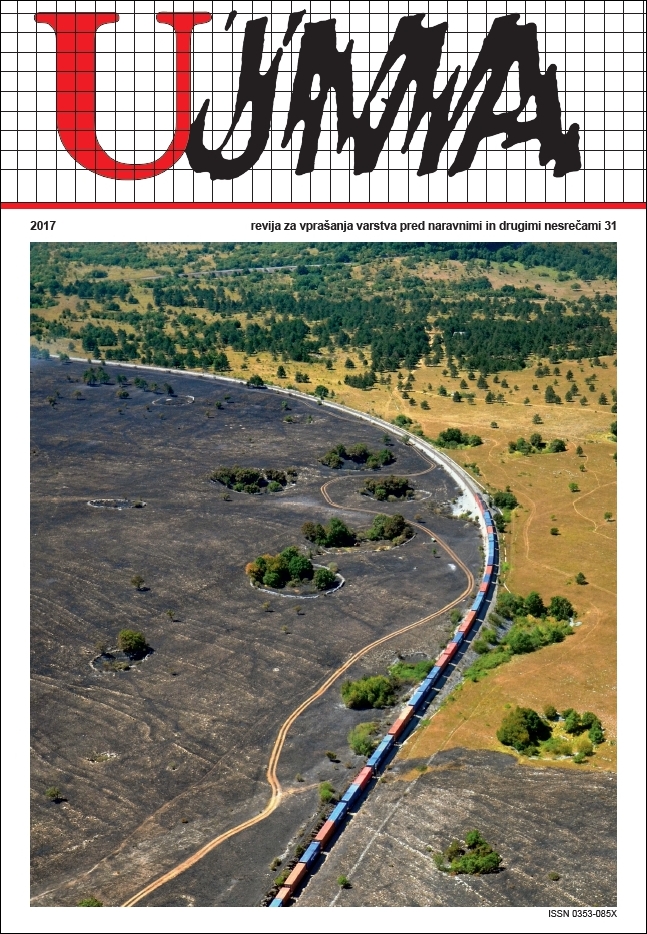AREA MANAGEMENT AROUND HAZARDOUS INDUSTRIAL INSTALLATIONS
Abstract
Spatial planners need clear and practical guidance on siting hazardous industrial installations. Previous proposals for considering risk assessment results in land-use planning in Slovenia were without formal implications. The reasons seem to be twofold; one is their emphatic theoretical and analytical form, and the other is that they were not presented in an operational form suitable for land-use planning purposes. The consequence is an undefined process for both land-use arrangements around existing hazardous installations, and the siting of new installations. The case study presented, of an LPG storage and handling facility in Ljubljana, provides information on how risk assessments may assist in avoiding the aforementioned issues, enabling long-term solutions for spatial development needs with the least consequences in case of industrial incidents.
References
Campedel, M., Cozzani, V., Garcia-Agreda, A., Salzano, E., 2008. Extending the Quantitative Assessment of Industrial Risks to Earthquake Effects, Risk Analysis, 28, 5, DOI: 10.1111/j.1539-6924.2008.01092.x
Cozzani, V., Bandini, R., Basta, C. and Christou, M. D., 2006. Application of land-use planning criteria for the control of major accident hazards: A case-study. J. Haz. Mat., 136, 170–180.
Dobashi, R., 2014. Fire and explosion disasters occurred due to the Great East Japan Earthquake (March 11, 2011). Journal of Loss Prevention in the Process Industries, 31, 121–126.
Directive 2012/18/EU of the European Parliament and of the Council of 4 July 2012 on the control of major-accident hazards involving dangerous substances, amending and subsequently repealing Council Directive 96/82/EC.
HSE, 1997. Derivation of fatality probability for occupants of buildings subject to blast loads, HSE (1997), http://www.hse.gov.uk/research/crr_pdf/1997/crr97147.pdf, marec 2017.
HSE, 2014. Methods of approximation and determination of human vulnerability for offshore major accident hazard assessment, http://www.hse.gov.uk/foi/internalops/hid_circs/technical_osd/spc_tech_osd_30/spctecosd30.pdf, marec 2017.
HSE, Helath and safety Executive, 2015. The storage of flammable liquids in tanks. HSG176 (Second edition), http://www.hse.gov.uk/pubns/books/hsg176.htm, 1. 3. 2017.
Kontić, D., 2008. Introduction of threat analysis for hazardous industrial installations into the land-use planning process: dissertation. Nova Gorica, http://www.ung.si/~library/doktorati/okolje/11Kontic.pdf, 1. 8. 2017.
Kontić, D., Kontić, B., 2009. Introduction of threat analysis into the land-use planning process. Journal of Hazardous Materials, 163, 683–700.
Kovačič, M., 2016. Vključevanje rezultatov analiz tveganja v načrtovanje namenske rabe prostora. Diplomsko delo. Univerza v Ljubljani – Biotehniška fakulteta, Ljubljana.
La Chance, J. L, Tchouvelev, A., Engebo, A., 2011. Development of uniform harm criteria for use in quantitative risk analysis of the hydrogen infrastructure. Int. Journal of Hydrogen Energy, 36, 2381–2388.
Matko, M., Golobič, M., Kontić, B., 2017. Reducing risks to electric power infrastructure due to extreme weather events by means of spatial planning: Case studies from Slovenia. Utilities Policy, 44, 12–24.
Mlakar, A., Marušič, J., 2000. Ranljivost okolja in vprašanje prostorske informacijske enote, kot ga je nakazal projekt ONIX-GPOV. Urbani izziv, 11 (2000) 96–101.
MOL – Mestna občina Ljubljana, 2009. Ocena ogroženosti Mestne občine Ljubljana zaradi nesreč z nevarnimi snovmi za uporabo v sistemu zaščite, reševanja in pomoči MOL. Mestna občina Ljubljana, Mestna uprava, Oddelek za zaščito, reševanje in civilno obrambo, dokument št. 842-12/2009.
MOL – Mestna občina Ljubljana, 2015a. Zabeležka sestanka 7. 1. 2015. Oddelek za urejanje prostora, št. 3504-5/2015-2, 16. 1. 2015.
MOL – Mestna občina Ljubljana, 2015b. Zabeležka sestankov 28. 9. 2015 in 16. 10. 2015. Oddelek za urejanje prostora, št. 3505-43/2012-176, 16. 10. 2015.
MOP, Ministrstvo za okolje in prostor, 2015. Sklep o potrebnosti izvedbe postopka presoje vplivov na okolje in pridobitvi okoljevarstvenega soglasja za načrtovano gradnjo platoja za mobilno asfaltno bazo podjetja VOC Celje, d.o.o., št 35405-440/2015-3, 23. 12. 2015.
Novak Pintarič, Z., 2016. Ocene vplivnih območij za določanje varnostnih razdalj pri obratih utekočinjenega naftnega plina. Ujma, 30, 143–150.
Ocena, 2015. Ocena možnosti za postavitev skladišča UNP – Poročilo prve faze. Institut Jožef Stefan, IJS-DP-11864.
Odlok, 2016. Odlok o občinskem podrobnem prostorskem načrtu 386 Poslovna cona Litostroj. Uradni list RS, št. 7/16.
Strokovne podlage, 2014. Strokovne podlage o varstvu pred vplivi industrijskih nesreč za OPPN 386 Poslovna cona Litostroj (P-ZIN-9/14), IJS-DP-11709, Institut „Jožef Stefan“, Ljubljana, oktober 2014.
Uredba, 2008. Uredba o merilih za določitev najmanjše razdalje med obratom in območji, kjer se zadržuje večje število ljudi, ter infrastrukturo. Uradni list RS, št. 34/08.
VP, 2013. Varnostno poročilo za skladiščenje utekočinjenega naftnega plina v Butan Plinu. Butan Plin, št. del. naloga 19/2012, 20.08.2010, dopolnjeno 19. 4. 2012 in 24. 1. 2013.
World bank, 1988. WORLD BANK – Techniques for Assessing Industrial Hazards (1988), http://www-wds.worldbank.org/servlet/WDSContentServer/WDSP/IB/2004/01/27/000178830_98101904165042/Rendered/PDF/multi0page.pdf, marec 2017.
ZAG – Zavod za gradbeništvo Slovenije, 2010. Poročilo št. P 0658/10-650-1 o oceni potresne varnosti baterije plinskih rezervoarjev za propan-butan, Ljubljana 30. 6. 2010.
Downloads
Published
Issue
Section
License

This work is licensed under a Creative Commons Attribution-NonCommercial-NoDerivatives 4.0 International License.
The articles are made available to the public under Creative Commons Attribution-NonCommercial-NoDerivatives 4.0 International (CC BY-NC-ND 4.0).


